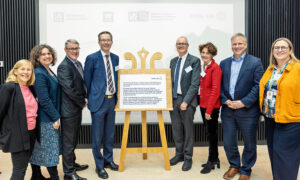
Five for the future
Scientists from EMBL’s five sites reflect on the hot opportunities and tricky challenges that might lie ahead in the coming years in their fields of research.


Anniversaries inevitably turn our thoughts to the past. But as these five visions make clear, the life sciences continue to hold enormous potential for future discovery. One of the most important objectives lies in unravelling the complexity inherent in all living beings. We have come a long way in understanding the components of biological systems, but there is still a lot to learn about how these components interact and create higher-level phenomena. This requires us to bring together increasing amounts of knowledge from diverse fields, as well as developing ways of using technologies and statistical methods to analyse and present huge volumes of data in ways that can be intuitively understood. Doing so could enhance a wide range of fundamental and clinical areas and, crucially, bridge gaps in knowledge between levels of organisation – from molecules, through cells, to organisms. Forecasts are inherently difficult to make, but we can be fairly sure that, if harnessed properly, molecular life science will contribute as much to our understanding of the human condition in the next 40 years as it has in the previous four decades.
Iain Mattaj, Director General, EMBL
Faster, higher, stronger

How do drugs bind to a target? Why do enzymes only work with certain substrates? How can gene mutations cause fatal diseases? Innovations in structural biology continue to advance, allowing us to extract detailed information on the atomic structure of target molecules, unravel their function and properties, and enable scientists to shed light on fundamental questions in molecular biology. And the targets we work with are now larger, more complex and more fragile than ever.
At EMBL Hamburg, we have had the first taste of our brand new beamlines at PETRA III – one of the most brilliant storage ring-based X-ray radiation source in the world – and it very exciting to be a part of the crystallography team as we move towards faster data collection, higher precision and stronger integration of interdisciplinary approaches. During the past year, we have demonstrated our excellent beam quality at a very broad energy range and proven we can determine structures of extreme samples: the tiniest crystals composed of largest repeating units. Our armoury enables researchers to tackle this type of challenging project in a truly integrated way, as PETRA III brings together sample characterisation, high-throughput crystallisation, crystallography and small-angle scattering beamlines, computational services and most importantly, inspirational scientists.
In Hamburg we are also on the brink of a new era with serial femtosecond crystallography and single particle imaging – techniques that will be made possible by the European Free Electron Laser (XFEL) facility, which is currently under construction. We are curious and excited to have a complementary source on site that will enable us to capture ‘diffraction before destruction’ and deliver structural information not amenable by other means. EMBL is coordinating the XFEL-based biology infrastructure at the European Free Electron Laser, and together with the launch of the new Centre for Structural Systems Biology; the emerging facilities will replenish our existing position at the forefront of molecular biology.
Johanna Kallio, staff scientist, EMBL Hamburg
Of genes and behaviour

In the past few years, pharmaceutical companies all over the world have closed their neuroscience research facilities. Why? Because the drugs developed in cell culture and animal models don’t work in the clinic. This is particularly true in the area of psychiatric disorders where no novel drugs have entered the market since the 1980s. The reason for this is the poor understanding we have of that makes us tick – and how this goes wrong in mental illness. At the moment, there is no blood test for anxiety or scan for bipolar disorder – their fundamental causes are dependent on complex interactions between molecular players – and we just don’t know what these are nor in what cells in the brain they happen. What’s more, we still know next to nothing about the push-and-pull between those molecular aspects and environmental factors such as stress, diet, and lifestyle.
But things could soon change. New tools in genetics and circuit manipulation have seen a boost in the past few years. Large multisite research programmes are starting to reliably find genes that underlie mental conditions – we are not sure yet how they control behaviour, but there is hope that they will give us an entry point for at least some disorders. We don’t know how they act because we don’t know the cells involved. That’s because until recently, it was impossible to block or selectively mimic neural activity in defined cell types in the brain in the living animal. Optogenetics has radically changed that – and now we can re-engineer neurons essentially at will. This will help us understand the missing link between genes and behavior. Initial breakthroughs will come in simple organisms – flies and worms. But mice and monkeys are not far behind and the time will come quickly when we can turn on and off emotions and reshape cognitive capacities. The next challenge will be how to make novel drugs that interact with these circuits to improve resilience, turn up or down plasticity, help us reshape our responses to the world around us, and curb our pathological impulses. Keep tuned for the new you!
Cornelius Gross, Deputy Head, EMBL Monterotondo
The next generation

The dramatic advancement of DNA sequencing technology over the past five years has transformed the DNA sequencer into the microscope of modern biology.
As the invention of the microscope changed the world by making it possible for scientists to study essentially everything around them, DNA sequencing has opened up an entirely new way of understanding nearly all aspects of biology. Sequencing is radically changing the way we track disease or infection outbreaks, as it can be used to clearly identify life forms on surfaces in hospitals. Similarly, it is allowing us to discover and explore whole new worlds of life: in the seawater, in the soil and in the communities of microorganisms we share our bodies with. In the not-too-distant future, sequencing will detect and monitor the growth of cancer and help suggest treatments.
Today’s newest sequencing machines are smaller than a candy bar, but future tools for DNA sequencing will be smaller and faster still, making them ever more useful and flexible. Of course these tools are critical in the age of genomic medicine, which is arriving in healthcare systems throughout the world, but their impact will be felt far beyond the hospital. In everyday life, DNA sequencing will certify the food we eat and help solve crimes. Together with the science of genomics, DNA sequencing has brought about the most important and far-reaching shift the practice of biology since the rise of molecular biology in the first half of the 20th century.
But what’s next? These technologies are advancing so quickly that we are bound to start equating today’s sequencing with the sound of a dial-up modem, or typing an email as green text on a bowed black screen. It will be fascinating to see how future hand-held devices might read sequences and combine them with expression and many other types of molecular data – from many different sources – and change the way we ask questions about the world, again.
Paul Flicek, group leader, EMBL-EBI
Wonders of the deep

Imagine a person living in the late 1970s – a time when the Walkman cassette player hit the streets, the videogame Space Invaders crackled onto our screens, and rollerblades began to spin off the production line. Now try to imagine how he or she would have predicted today’s world based on their knowledge and experiences then – I dare say the forecast would have been quite different to what we find now. Because the great thing about the future is that it is much more than just an extrapolation from the current reality. Even so, I find it incredibly exciting to imagine the potential for new discoveries – particularly in studying the world’s oceans. Modern satellites, remotely operated vehicles, and computer simulations allow researchers to explore the deep in increasingly scientific and systematic ways. Yet ninety-five percent of the ocean remains unexplored. What is down there? Can we match our knowledge of sea creatures with what we know about terrestrial life? What secrets might we reveal?
One exciting prospect is that, by studying the ocean’s inhabitants, we can learn a great deal about how life works – and in surprising ways. Life began in the ocean, and learning more about it presents a great chance to put our understanding of the basic building blocks of life and the organisation of processes and organisms into perspective. We can start to understand, for instance, how parasitic and symbiotic relationships have shaped evolution; shed light on the different stages of evolution; and even learn more about possible forms of life. Using genomic and molecular techniques, we can begin to fill in gaps in our knowledge – and learn more about our transition from primitive sea creatures into complex mammals that can speak, hear, feel, learn, and think. By doing so, we can enrich our view of life and learn much more about ourselves, perhaps in ways one cannot even dream of today.
Silvia Rohr, PhD student, EMBL Heidelberg
Instrumental to success

The field of X-ray crystallography is celebrating 100 years of incredible discoveries – from helping to make medicine, to enhancing the efficiency of batteries, to improving the taste and texture of chocolate. Today, surprises seemingly lie in wait around every corner, with fields such as genomics, proteomics, and pharmacology benefiting from significant increases in analytical speed, throughput, and accessibility. Their continual evolution provides an endless supply of tiny molecular players to be determined in 3D so that fundamental questions about their role in biology, health and disease can be identified. The next generation of synchrotrons and X-ray free electron lasers add to this sense of anticipation – presenting an opportunity to overcome many of our current limitations, particularly in the study of larger and more complex biological systems.
Crystallography, however, remains a very difficult science – and the quantities, size differences, and unique nature of crystals demanded by modern research projects increasingly require us to quickly think on our feet. One current challenge is the routine growth of diffraction-quality crystals – particularly difficult in studies involving complex membrane proteins or biological assemblies. Another is the efficient measurement of diffraction data from these crystals, which due to their size are inherently difficult to study. Overcoming such obstacles may require ingenious approaches to automation, robotics, computation, software, and more, but doing so will enhance our efforts to interpret the wealth of information produced by modern science. I am confident we can meet these challenges, and go far beyond: recent innovations in sample handling, instrumentation, computational methods, and data collection here at EMBL and elsewhere show what can be achieved by smart thinking, persistence and teamwork. Such developments can be a driving force for science, and our combined efforts will accelerate the pace of discovery, aid drug design and allow us to better understand the folds, functions and fabrics of life.


